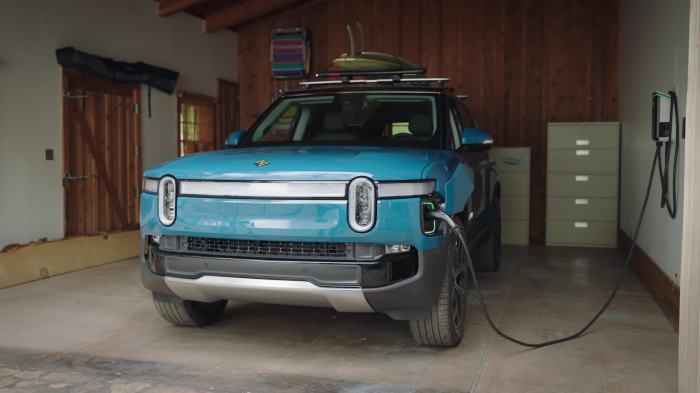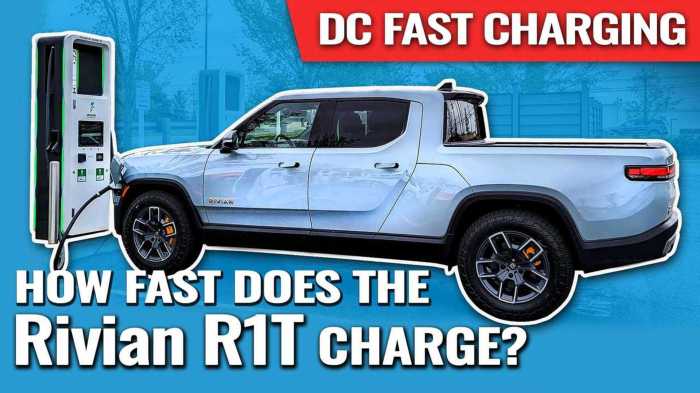How long to charge a Rivian R1T at home? That’s the million-dollar question (or, more accurately, the several-thousand-kilowatt-hour question!), especially for anyone considering this awesome electric truck. Charging times depend on a bunch of factors, from the type of home charger you have to the outside temperature. We’re diving deep into all the variables that affect your Rivian’s charging speed so you can plan your electric adventures accordingly.
This guide breaks down everything you need to know about charging your Rivian R1T at home, from understanding the different charger types and their pros and cons to troubleshooting potential problems and exploring future charging tech. We’ll also look at the cost of charging and how to maximize efficiency, so you can keep your R1T juiced up without breaking the bank (or the planet!).
Get ready to become a home-charging expert!
Charging Time Variables
Charging your Rivian R1T at home isn’t a one-size-fits-all affair. The time it takes to fully juice up your electric truck depends on several factors, primarily the power of your home charger and the current state of your battery. Ambient temperature also plays a significant role.Home charging speed is directly correlated to the power level of your charging station.
A higher-powered charger delivers more energy to the battery in a shorter amount of time.
Home Charger Power Levels and Charging Times
The following table illustrates estimated charging times for a Rivian R1T, assuming a roughly 135 kWh usable battery capacity. These are estimates, and actual times may vary depending on the factors discussed below.
| Charger Type | Voltage (V) | Amperage (A) | Approximate Charging Time (hours) |
|---|---|---|---|
| 110V Outlet (Standard Household) | 110 | 12-15 | 50+ |
| 220V Outlet (Common for Appliances) | 220 | 30-40 | 15-20 |
| Level 2 Charger (240V) | 240 | 40-80 | 8-12 |
| Level 2 Charger (240V – High Power) | 240 | 80+ | 6-8 |
Battery State of Charge (SOC) Impact
The starting state of charge significantly impacts charging time. Charging from 20% to 80% SOC is generally faster than charging from 80% to 100%. This is due to the battery management system (BMS) slowing charging at higher SOC levels to manage heat and optimize battery longevity. For example, adding 60 kWh to a battery from 20% might take 6 hours, while adding the final 20 kWh might take another 4 hours.
Ambient Temperature Effects
Extreme temperatures, both hot and cold, can reduce charging speed. In frigid conditions, the battery’s internal resistance increases, slowing the charging process. Similarly, excessive heat can also impact charging efficiency and potentially trigger safety mechanisms that slow or halt charging to prevent damage. Ideally, charging in moderate temperatures (around 60-75°F or 15-24°C) yields the fastest and most efficient charging.
Think of it like this: a cold engine takes longer to warm up and perform optimally, just as a cold battery takes longer to charge effectively.
Home Charger Types and Their Impact

Choosing the right home charger for your Rivian R1T significantly impacts your charging experience. The speed and convenience of charging at home directly relate to the type of charger you install. This section breaks down the differences between Level 1 and Level 2 chargers, along with installation considerations and cost implications.Level 1 and Level 2 chargers offer vastly different charging speeds and experiences.
Understanding these differences is crucial for deciding which option best suits your lifestyle and needs.
Level 1 vs. Level 2 Charger Comparison
The primary distinction between Level 1 and Level 2 chargers lies in their power output and, consequently, their charging speeds. Level 1 chargers use standard household outlets (120V), while Level 2 chargers utilize dedicated circuits (240V). This voltage difference dramatically affects charging times.
- Level 1 Charger: This uses a standard 120V outlet and provides a very slow charging rate, adding only a few miles of range per hour. This is suitable only for topping off the battery occasionally or in emergencies.
- Level 2 Charger: This uses a dedicated 240V circuit and provides significantly faster charging speeds, adding tens of miles of range per hour. This is the recommended option for regular home charging of an EV like the Rivian R1T.
Here’s a table summarizing the pros and cons:
| Feature | Level 1 Charger | Level 2 Charger |
|---|---|---|
| Charging Speed | Very slow (a few miles per hour) | Fast (tens of miles per hour) |
| Installation | Plug and play, no installation required | Requires professional installation |
| Cost | Low initial cost (charger is inexpensive) | Higher initial cost (charger and installation) |
| Convenience | Convenient for occasional use | More convenient for daily charging |
| Ideal Use Case | Emergency charging, occasional top-ups | Daily charging, maximizing range |
Home Charger Installation and Costs
Installing a Level 2 charger typically involves a qualified electrician running a dedicated 240V circuit from your electrical panel to the charging location. The cost of installation varies greatly depending on factors like the distance to your electrical panel, the need for additional electrical work, and local labor rates. You can expect to pay anywhere from a few hundred to over a thousand dollars for professional installation.
Level 1 chargers, on the other hand, require no installation; simply plug it into an existing outlet. However, it’s advisable to use a dedicated circuit for a Level 1 charger to avoid overloading the circuit.
Selecting the Appropriate Home Charger for the Rivian R1T
For most Rivian R1T owners, a Level 2 charger is the clear winner. The significantly faster charging speeds make it far more convenient for daily use. Consider the following factors when choosing a Level 2 charger:
- Charging Speed (kW): Higher kW ratings mean faster charging. Rivian recommends a charger capable of at least 7kW. However, some models can support much higher charging rates.
- Smart Features: Some Level 2 chargers offer smart features like scheduling charging times, monitoring energy consumption, and integrating with home energy management systems. These features can enhance convenience and efficiency.
- Installation Requirements: Ensure the charger is compatible with your home’s electrical system. A qualified electrician can assess your needs and recommend a suitable charger and installation plan.
- Budget: Factor in the cost of the charger itself and the professional installation fees. While the upfront cost of a Level 2 charger and installation is higher than a Level 1 charger, the long-term convenience and time savings usually outweigh the initial investment.
Factors Affecting Charging Speed

So, you’ve got your sweet Rivian R1T and you’re ready to juice it up at home. But how fast will it actually charge? It’s not just a simple matter of plugging it in; several factors influence the charging speed, from the truck itself to your home’s electrical setup. Let’s break down what affects your charging time.The Rivian R1T uses a sophisticated onboard charging system to manage the power flow from your home charger to its battery pack.
This system constantly monitors the battery’s state of charge, temperature, and overall health. It then adjusts the charging rate accordingly to optimize charging speed while also protecting the battery’s longevity. Think of it as a smart, built-in power manager for your EV’s battery. This intelligent system helps prevent overcharging and ensures the battery doesn’t get stressed during the charging process.
It also dynamically adjusts charging based on factors like ambient temperature; on a hot summer day, it might charge a bit slower to prevent overheating.
Potential Charging Speed Issues
Several things can potentially slow down your R1T’s charging. Faulty wiring in your home’s electrical system, for example, can create resistance and reduce the amount of power reaching the vehicle. Similarly, a malfunctioning home charger—whether it’s a damaged cable, a problem with the charging unit itself, or even just a loose connection—can significantly impact charging speed. Furthermore, if your home’s electrical panel is overloaded with other appliances running concurrently, this can reduce the available power for the R1T, leading to slower charging.
A less common issue could involve a problem with the Rivian’s onboard charging system, which would require a service visit to diagnose and repair.
Tips for Maximizing Charging Efficiency
To get the most out of your home charging setup, consider these tips. First, ensure you have a dedicated circuit for your EV charger. This prevents other appliances from competing for power and maximizes the charging rate. Second, regularly inspect your charging cable and the charger unit itself for any signs of damage. A frayed cable or a loose connection can drastically reduce charging efficiency.
Third, keep your battery’s temperature within the optimal range. Extreme heat or cold can impact charging speed. Finally, make sure your home’s electrical panel has sufficient capacity to handle the charging load without tripping the breaker. Upgrading your panel might be necessary if you have an older home or many high-power appliances. Consulting with a qualified electrician is recommended to address any potential issues with your home’s electrical system to ensure safe and efficient charging.
Charging a Rivian R1T at home? It depends on your charger, but expect a pretty long time. Thinking about the long-term costs? Check out this article on the Tax Credit for Used Electric Cars 2025 to see if you can snag some savings on your next EV purchase, which could help offset the charging costs over time.
Ultimately, how long it takes to juice up your R1T depends on your setup and power.
Charging Time Estimates
Estimating the charging time for your Rivian R1T at home depends heavily on several factors, as we’ve discussed. This section provides a clearer picture by offering estimated charging times under various conditions and common driving scenarios. Remember, these are estimates, and your actual charging time may vary.
The following table provides estimated charging times based on the Rivian R1T’s large battery pack and different home charging setups. These estimates assume optimal charging conditions (correct voltage, temperature, etc.).
Estimated Charging Times
| Charge Increase (%) | Level 1 (120V) | Level 2 (240V, 32A) | Level 2 (240V, 48A) |
|---|---|---|---|
| 0-20% | ~3-4 hours | ~30-45 minutes | ~20-30 minutes |
| 20-40% | ~3-4 hours | ~30-45 minutes | ~20-30 minutes |
| 40-60% | ~3-4 hours | ~45-60 minutes | ~30-40 minutes |
| 60-80% | ~3-4 hours | ~60-75 minutes | ~40-50 minutes |
| 80-100% | ~4-5 hours | ~75-90 minutes | ~50-60 minutes |
Note: Level 1 charging is significantly slower than Level 2. The higher amperage Level 2 charger (48A) provides the fastest charging speeds. These times are approximations and can be affected by factors like ambient temperature and battery state.
Daily Driving Scenarios and Charging Needs
Let’s look at some common daily driving situations and how much charging you might need.
Scenario 1: Short Commute (20 miles round trip): A short daily commute likely only uses a small percentage of your battery. You might only need to top up 10-15% overnight on Level 1 or even skip charging entirely some days.
Scenario 2: Longer Commute (50 miles round trip): A longer commute will consume a larger portion of your battery. You’ll probably need to charge 30-40% overnight on Level 2 for a full charge, or potentially use a faster charger during the day if needed.
Scenario 3: Weekend Trip (200 miles): A weekend trip will require a significant amount of charging. You’ll likely need a full charge (or close to it) before you leave. This would take approximately 6-8 hours on Level 2 (32A) or about 4-5 hours on Level 2 (48A).
These scenarios highlight the importance of understanding your typical driving patterns to best manage your charging schedule. Planning ahead and utilizing the appropriate charging level will ensure you’re always ready for your next adventure.
Electricity Consumption and Cost
Charging your Rivian R1T at home will inevitably add to your electricity bill. The exact cost depends on several factors, primarily your vehicle’s battery size, your electricity rate, and your charging habits. Understanding these factors is crucial for budgeting and managing your energy expenses.The Rivian R1T’s large battery pack requires a significant amount of electricity to fully charge. Let’s assume a full charge consumes approximately 135 kWh (kilowatt-hours), which is a reasonable estimate for the larger battery pack.
This number can vary slightly based on factors like temperature and driving style, but it serves as a good starting point for our calculations.
Electricity Cost Calculation Examples
To determine the cost of a full charge, we need your local electricity rate. Let’s look at a few examples:
- Low-cost electricity (example: $0.12/kWh): 135 kWh
– $0.12/kWh = $16.20. At this rate, a full charge would cost approximately $16.20. - Average-cost electricity (example: $0.15/kWh): 135 kWh
– $0.15/kWh = $20.25. A full charge would cost roughly $20.25. - High-cost electricity (example: $0.25/kWh): 135 kWh
– $0.25/kWh = $33.75. At this higher rate, a full charge would cost about $33.75.
These examples illustrate how your electricity rate significantly impacts the cost of charging. Remember to check your electricity bill for your precise rate, as it may vary depending on time of day or usage tiers.
Strategies for Minimizing Electricity Costs
Several strategies can help reduce the cost of charging your Rivian R1T at home.
- Time-of-Use (TOU) Plans: Many electricity providers offer TOU plans with lower rates during off-peak hours (typically overnight or early mornings). Scheduling your charging during these off-peak periods can significantly lower your overall cost.
- Solar Power: Installing solar panels on your home can offset or even eliminate the cost of charging your electric vehicle. The initial investment is substantial, but the long-term savings can be significant.
- Optimize Charging Habits: Avoid completely depleting your battery before charging. Smaller, more frequent charging sessions can be more efficient and potentially less expensive than one large charge.
Tracking Energy Consumption
Monitoring your energy consumption during charging allows you to track costs and identify areas for improvement.
- Smart Home Chargers: Many Level 2 chargers offer smart features, including energy monitoring capabilities. These chargers often provide detailed reports on energy usage through a mobile app.
- Electricity Meter: Take a meter reading before starting a charge and again after it’s complete. The difference will show you the kWh consumed during that charging session.
Safety Precautions During Home Charging
Charging your Rivian R1T at home is convenient, but safety should always be your top priority. Ignoring safety precautions can lead to serious consequences, from minor inconveniences to significant damage to your vehicle or even personal injury. This section Artikels essential safety guidelines to ensure a smooth and safe charging experience.
Improper home charging practices can present several hazards. These range from the risk of electric shock and fire to damage to your vehicle’s charging system and even potential harm to your home’s electrical infrastructure. Understanding these risks and following the proper procedures is crucial for minimizing these potential dangers.
Potential Hazards Associated with Improper Home Charging
Several potential dangers exist when charging your electric vehicle improperly at home. These hazards are not hypothetical; they are real and have the potential to cause significant damage or injury. Understanding these risks allows for proactive measures to be taken to prevent accidents.
- Electric Shock: Faulty wiring, damaged charging cables, or improper grounding can lead to electric shock. This is a serious risk that can result in injury or even death.
- Fire Hazards: Overheating charging cables, overloaded circuits, or damaged charging equipment can initiate a fire. This risk is heightened if flammable materials are near the charging station.
- Damage to Vehicle Charging System: Using an incompatible charger or improperly connecting the charging cable can damage the vehicle’s onboard charging system, leading to costly repairs.
- Damage to Home Electrical System: Overloading your home’s electrical circuits can cause damage to your wiring, breakers, and other electrical components, potentially leading to power outages or even a house fire. A poorly installed charging station can also cause damage to the electrical system of your home.
Safe Home Charging Checklist
Before you plug in your Rivian R1T, it’s essential to follow a checklist to ensure a safe charging process. This simple routine can significantly reduce the risk of accidents. Think of it as a pre-flight checklist for your electric vehicle.
- Inspect the Charging Cable: Check the cable for any visible damage, such as fraying, cuts, or exposed wires. Do not use a damaged cable.
- Inspect the Charging Station: Examine the charging station for any signs of damage or overheating. Look for any loose connections or signs of water damage.
- Ensure Proper Grounding: Verify that the charging station is properly grounded to prevent electric shock. This is critical for safety.
- Avoid Overloading Circuits: Ensure your home’s electrical system can handle the added load of charging your Rivian. Consult an electrician if you have any doubts.
- Keep the Area Clear: Maintain a clear space around the charging station, free from flammable materials and obstructions. This prevents accidental fires and tripping hazards.
- Monitor the Charging Process: Keep an eye on the charging process, especially during the initial stages. Listen for any unusual sounds or smells.
- Unplug Safely: Always unplug the charging cable from the vehicle before unplugging it from the wall outlet. This prevents accidental shocks.
Comparison with Other EVs
Charging your Rivian R1T at home is a key aspect of ownership, but how does its charging time stack up against competitors? Let’s compare it to other popular electric trucks and SUVs to get a better understanding. Remember that actual charging times can vary significantly based on factors we’ve already discussed.
So, you’re wondering how long it takes to juice up your Rivian R1T at home? It really depends on your charger, but figuring that out is key to EV ownership. If you’re looking for other family-friendly electric options, check out this list of Top-rated EVs for families 2025 to see what else is out there. Then, you can compare charging times and decide what best suits your needs and the R1T’s charging time might seem pretty standard!
Several factors influence the charging speed differences between EVs. Battery capacity is a major player – larger batteries naturally take longer to fill. The onboard charger’s power (kW) is crucial; a higher kW charger means faster charging. The type of charging station (Level 2 home charger vs. DC fast charger) also makes a huge difference, with DC fast charging being significantly quicker but generally not available at home.
Finally, the charging curve of the battery itself plays a role; many EVs charge faster at lower state-of-charge (SOC) and slow down as they approach 100%.
Charging Time Comparison, How long to charge a Rivian R1T at home
| Vehicle | Battery Capacity (kWh) | Home Charging Time (80% from 20%, estimated) | Factors Affecting Time |
|---|---|---|---|
| Rivian R1T | 135 kWh (Large Pack) | ~10-12 hours (Level 2, 240V) | Onboard charger, battery chemistry, charging curve |
| Ford F-150 Lightning | 98 kWh (Standard Range) | ~8-10 hours (Level 2, 240V) | Onboard charger, battery chemistry, charging curve |
| Hummer EV | 212.7 kWh | ~14-16 hours (Level 2, 240V) | Large battery capacity, onboard charger |
| Tesla Model Y | 75 kWh (Standard Range) | ~6-8 hours (Level 2, 240V) | Smaller battery, efficient charging system |
Note: These are estimated times and can vary depending on factors like ambient temperature and charging station conditions. Always refer to the manufacturer’s specifications for precise information.
Charging Infrastructure Implications
The differences in charging times directly impact the development and adoption of charging infrastructure. The longer charging times of some EVs, like the Hummer EV with its massive battery, necessitate a higher number of charging stations to meet consumer demand, especially in areas with limited access to high-power charging. Conversely, EVs with faster home charging times like the Tesla Model Y might require a less dense public charging network, allowing for a more focused investment in fast-charging stations for longer journeys.
This interplay between vehicle charging characteristics and infrastructure requirements is a crucial factor in the overall success of EV adoption.
Troubleshooting Charging Issues
So, your Rivian R1T isn’t charging as expected? Don’t panic. Charging issues are fairly common with EVs, and most are easily resolved. This section will walk you through identifying and fixing common problems to get you back on the road quickly. Remember, safety is paramount; always follow the manufacturer’s instructions and disconnect the charger before attempting any physical troubleshooting.Troubleshooting charging problems involves a systematic approach.
First, you need to identify the issue, then check the obvious things, and finally, contact support if necessary. This process will minimize downtime and frustration.
Common Charging Problems and Solutions
Several issues can prevent your Rivian R1T from charging correctly at home. Addressing these potential problems methodically is key to a quick resolution.
- Problem: The charging level is not increasing. Solution: Check the charging cable connection at both the vehicle and the charger. Ensure the cable is securely plugged in at both ends. Try a different outlet. Check the breaker box to ensure the circuit hasn’t tripped.
If the problem persists, inspect the charging cable for any visible damage.
- Problem: The charging indicator light on the vehicle or charger is not illuminated or displays an error code. Solution: Consult your Rivian owner’s manual to understand the meaning of the error code. This will often provide clues to the problem. Try restarting the charging process by unplugging and replugging the charger. If the problem continues, contact Rivian support for assistance.
- Problem: The charging speed is significantly slower than expected. Solution: Check the temperature of the battery. Extreme temperatures (both hot and cold) can impact charging speed. Make sure the charging cable is properly connected. Consider whether your home’s electrical system is providing sufficient power.
If the issue remains, contact Rivian support.
- Problem: The onboard charging system is malfunctioning. Solution: This is less common but requires professional attention. Contact Rivian support immediately. Do not attempt to repair the onboard charging system yourself.
Troubleshooting Steps
A systematic approach to troubleshooting is crucial. Here’s a step-by-step guide to follow:
1. Check the Obvious
Begin by ensuring the charging cable is securely plugged into both the vehicle and the wall outlet. Inspect the cable for any visible damage, such as fraying or exposed wires.
2. Inspect the Outlet
Test the outlet with another device to ensure it’s working correctly. Check the breaker box to make sure the circuit hasn’t tripped.
3. Check the Vehicle
Examine the charging port on the vehicle for any obstructions or damage. Ensure the charging flap is fully closed and latched.
4. Review the Owner’s Manual
Consult your Rivian R1T owner’s manual for troubleshooting guidance and error code definitions.
5. Contact Rivian Support
If you’ve tried all the above steps and are still experiencing issues, contact Rivian customer support. They can provide further diagnosis and assistance.
Troubleshooting Flowchart
A flowchart visually represents the troubleshooting process. Imagine a flowchart starting with “Charging Issue?”. A “Yes” branch leads to “Check Cable Connections?”. A “Yes” from that leads to “Problem Solved?” If “No”, it leads to “Check Outlet & Breaker”. If “No” again, it goes to “Check Vehicle Charging Port”.
If “No” again, it leads to “Consult Owner’s Manual”. If the problem is still not solved, the final branch is “Contact Rivian Support”. A “No” branch from the initial “Charging Issue?” would indicate “No Problem”.
Future Charging Technologies: How Long To Charge A Rivian R1T At Home
The current landscape of home EV charging is rapidly evolving, driven by advancements in battery technology and a growing demand for faster, more convenient charging solutions. Future innovations promise to significantly reduce Rivian R1T charging times and reshape the home charging infrastructure. These advancements aren’t just about faster charging; they also address issues like grid stability and overall charging efficiency.The next generation of home charging technology will likely focus on several key areas: increased power delivery, smarter charging management, and more efficient energy transfer.
This will lead to substantial improvements in charging speed and overall convenience for Rivian R1T owners.
Higher-Power Home Charging Stations
Currently, many home chargers offer a maximum output of around 11 kW. However, future home charging stations are projected to support significantly higher power levels, potentially reaching 22 kW or even higher. This increased power output will translate directly into faster charging times for the Rivian R1T, potentially cutting charging times by half or more compared to current standards.
For example, a 22 kW charger could add a substantial range in a fraction of the time a standard 11 kW charger takes. This will be particularly beneficial for those with limited time for charging.
Smart Charging and Grid Integration
Smart charging technology will play a crucial role in optimizing charging schedules and managing energy consumption. Future chargers will likely incorporate features like load balancing, which automatically adjusts charging power based on overall household energy demand. This will prevent overloading the home’s electrical system and potentially integrate with renewable energy sources like solar panels. Imagine a scenario where your Rivian R1T charges primarily using excess solar energy generated during the day, minimizing reliance on the grid and lowering charging costs.
This intelligent integration will also help manage peak demand on the electrical grid, preventing strain on the system.
Wireless Charging Technology
While still in its early stages of development for automotive applications, wireless charging holds the potential to revolutionize the home charging experience. This technology eliminates the need for physical plugs and cables, offering a more convenient and aesthetically pleasing charging solution. However, significant advancements are needed to increase the efficiency and power transfer capabilities of wireless charging systems to make them viable for high-capacity batteries like those found in the Rivian R1T.
Challenges remain in terms of range and the efficiency of power transfer over a distance, but the potential for a truly seamless charging experience is considerable.
Improved Battery Chemistry and Thermal Management
Advancements in battery chemistry and thermal management systems will also play a significant role in faster charging times. Batteries that can handle higher charging rates without overheating will be essential for utilizing the full potential of higher-power charging stations. Better thermal management systems will allow for faster charging speeds while preventing damage to the battery, leading to a longer battery lifespan and improved overall vehicle performance.
Companies are actively investing in solid-state batteries and other battery technologies that promise faster charging and increased energy density, directly impacting charging times for EVs like the Rivian R1T.
Outcome Summary

So, how long does it
-really* take to charge your Rivian R1T at home? The answer, as we’ve seen, isn’t a simple number. It’s a dynamic equation influenced by your charger, the weather, your battery’s current state, and even your driving habits. By understanding these factors and following the tips and troubleshooting advice in this guide, you can optimize your charging experience and enjoy the freedom of electric driving without the range anxiety.
Happy charging!









